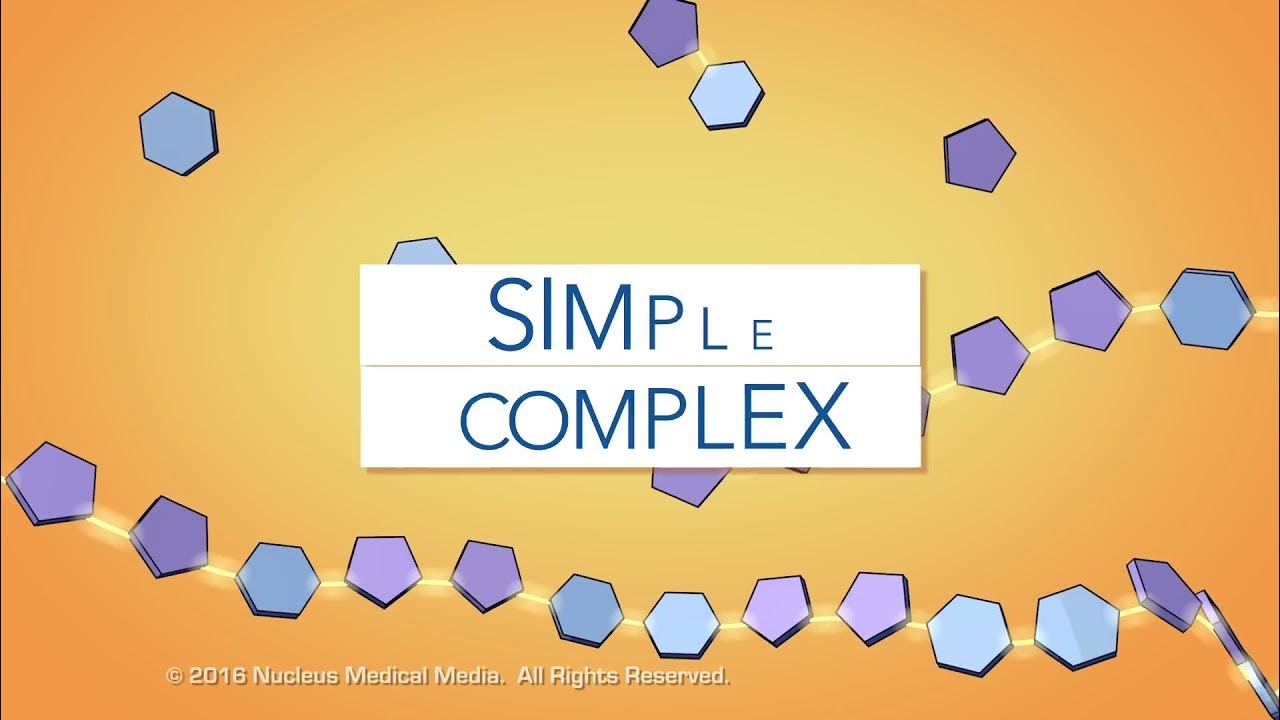Carbohydrates | Biological Molecules Simplified #1
Summary
TLDRThis 'Two-Minute Classroom' video delves into the world of carbohydrates, essential macromolecules composed of carbon, hydrogen, and oxygen in a 1:2:1 ratio. Carbohydrates, also known as sugars, serve various roles such as rapid energy production, energy storage in glycogen and starch, and structural components like cellulose and chitin. The video explains the hierarchy from monosaccharides like glucose and fructose to disaccharides like sucrose and lactose, and finally to polysaccharides. It also touches on the importance of lactase for lactose digestion and the significance of carbohydrates in living organisms.
Takeaways
- 🍚 Carbohydrates are macromolecules composed of carbon, hydrogen, and oxygen in a 1:2:1 ratio.
- 🍬 They are also known as sugars and serve several key functions in living organisms.
- ⚡ Carbohydrates are essential for rapid energy production through a process called glycolysis.
- 🐾 They also play a role in energy storage as glycogen in animals and starch in plants.
- 🌿 As a structural component, carbohydrates form cellulose in plants and chitin in crustaceans and insects.
- 🔍 The simplest carbohydrates are monosaccharides, which are single carbohydrate molecules like glucose, fructose, galactose, and ribose.
- 🍰 Disaccharides consist of two monosaccharides chemically bonded together, such as sucrose and lactose.
- 🥛 Lactose intolerance is due to a deficiency in lactase, the enzyme that breaks down lactose.
- 🍚 Polysaccharides are formed when more than two monosaccharides are combined, including starch, glycogen, and cellulose.
- 🔑 The way glucose monomers are bound together determines the type of polysaccharide formed.
- 📚 Understanding carbohydrates is crucial for grasping their importance in biological systems and nutrition.
Q & A
What are carbohydrates and what is their basic composition?
-Carbohydrates are macromolecules composed of carbon, hydrogen, and oxygen in a 1:2:1 ratio, which means there is one carbon for every two hydrogens and one oxygen.
Why are carbohydrates also referred to as sugars?
-Carbohydrates are known as sugars because they are made up of simple sugar units, and they serve as a primary source of energy in living organisms.
What are the key functions of carbohydrates in living organisms?
-Carbohydrates serve several key functions including rapid energy production through glycolysis, energy storage as glycogen in animals and starch in plants, and as a structural component in plants as cellulose and in crustaceans and insects as chitin.
What is a monosaccharide and give some examples?
-A monosaccharide is the simplest form of carbohydrates, which is a single carbohydrate molecule. Examples include glucose, which is a key energy source, fructose found in fruits, galactose found in yogurt, and ribose which helps form DNA.
What is the difference between glucose and fructose in terms of sweetness?
-Glucose is an important simple sugar and a key energy source, while fructose is found in many fruits and is sweeter than glucose.
What is a disaccharide and provide some examples?
-A disaccharide is formed when two monosaccharides are chemically bound together. Examples include sucrose, which is common table sugar formed from glucose and fructose, and lactose, the sweetener in milk formed from galactose and glucose.
What is lactose intolerance and how does it relate to lactase?
-Lactose intolerance is a condition where individuals have low levels of the protein lactase, which is necessary to break down lactose. Without sufficient lactase, the stomach can become upset when lactose is not broken down properly.
What are polysaccharides and how do they differ from monosaccharides and disaccharides?
-Polysaccharides are complex carbohydrates made up of many monosaccharide units linked together. Unlike monosaccharides and disaccharides, polysaccharides can be very large and serve different functions such as energy storage or structural support. Examples include starch, glycogen, and cellulose.
How does the way glucose is bound together affect the type of saccharide formed?
-The manner in which glucose molecules are linked together determines the type of saccharide formed, whether it is starch, glycogen, or cellulose, each serving different roles in organisms.
Why are carbohydrates considered important in a biological context?
-Carbohydrates are important because they play a crucial role in energy production, energy storage, and structural support within living organisms, making them essential for life processes.
What other macromolecules does the video creator discuss in other videos?
-In addition to carbohydrates, the video creator discusses proteins, lipids, and amino acids in other videos, providing insights into their structures and functions.
Outlines

This section is available to paid users only. Please upgrade to access this part.
Upgrade NowMindmap

This section is available to paid users only. Please upgrade to access this part.
Upgrade NowKeywords

This section is available to paid users only. Please upgrade to access this part.
Upgrade NowHighlights

This section is available to paid users only. Please upgrade to access this part.
Upgrade NowTranscripts

This section is available to paid users only. Please upgrade to access this part.
Upgrade Now5.0 / 5 (0 votes)





